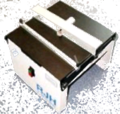Category:Working Plastics
From DT Online
Since the development of early Plastics, such as Celluloid, Bakelite, Perspex and Nylon, an ever-expanding variety now surrounds us, not only mimicking traditional or natural materials but also bringing with them particular properties and characteristics. The word ‘plastic’ is derived from ‘plastikos’, a Greek word meaning ‘capable of being shaped or molded’.
Note: this phrase also defines Malleability and many materials have a Plastic Stage as they are deformed. To avoid confusion, DT Online uses the term Plastics as both a singular and plural noun))
Synthetic* Plastics are chemically produced from oil and a wide, possibly infinite, variety is possible, but they all fit into one of two groupings:
- Thermoplastics - these can repeatedly be softened by heating and will return to a rigid state when cooled.
- this group includes: Acrylic, Polycarbonate (PC), Polyethylene, and Polypropylene.
- Thermosets - these are initially ‘cured’ (or set), often by mixing with a ‘hardener’ which creates a heat producing (Exothermic) chemical reaction and, once set cannot be softened again by further heating.
- this group includes: Polyester Resin, Epoxy Resin, Bakelite and Melamine.
*Note: Several natural materials may also be classified as Plastics. These include: Cellulose, Horn, Amber, and Shellac.
Plastics are formed by long chains of carbon based molecules, or Polymers, strongly bonded to each other. The Polymer Chains are either joined to each other with weak van der Vaals Forces to create Thermoplastics or much stronger Cross-Linking which results in Thermosets.
The almost universal use of plastics for packaging and other throw-away items is causing considerable environmental issues since they do not rot very easily. Also, most plastics are made from oil which is a diminishing resource so there is increasing demand for them to be recyclable. Much work currently therefore, is focussed on the research and development of Biodegradable Plastics which are derived from renewable resources.
Pages in category 'Working Plastics'
The following 5 pages are in this category, out of 5 total.
Media in category 'Working Plastics'
The following 16 files are in this category, out of 16 total.
- BlowMoulder.png 1,397 × 604; 141 KB
- BlowMoulderBases.png 992 × 571; 58 KB
- BlowMouldingRing.png 789 × 528; 76 KB
- ClarkeStripHeater.jpg 500 × 252; 14 KB
- DrapeMoulding.png 533 × 530; 48 KB
- Inverted L Calender.png 388 × 311; 13 KB
- MemoryStamp7.png 759 × 508; 45 KB
- MemoryStamp8.png 950 × 459; 37 KB
- MemoryStamp9.png 1,042 × 472; 161 KB
- Mold cavity.png 501 × 379; 37 KB
- PlasticDuck.png 197 × 256; 37 KB
- PressMoulding.png 1,073 × 500; 74 KB
- StripHeater.png 979 × 479; 65 KB
- Trimmer.png 170 × 161; 63 KB
- VacForming.png 865 × 279; 29 KB
- Www.GIFCreator.me scf30H.gif 384 × 236; 1.26 MB















